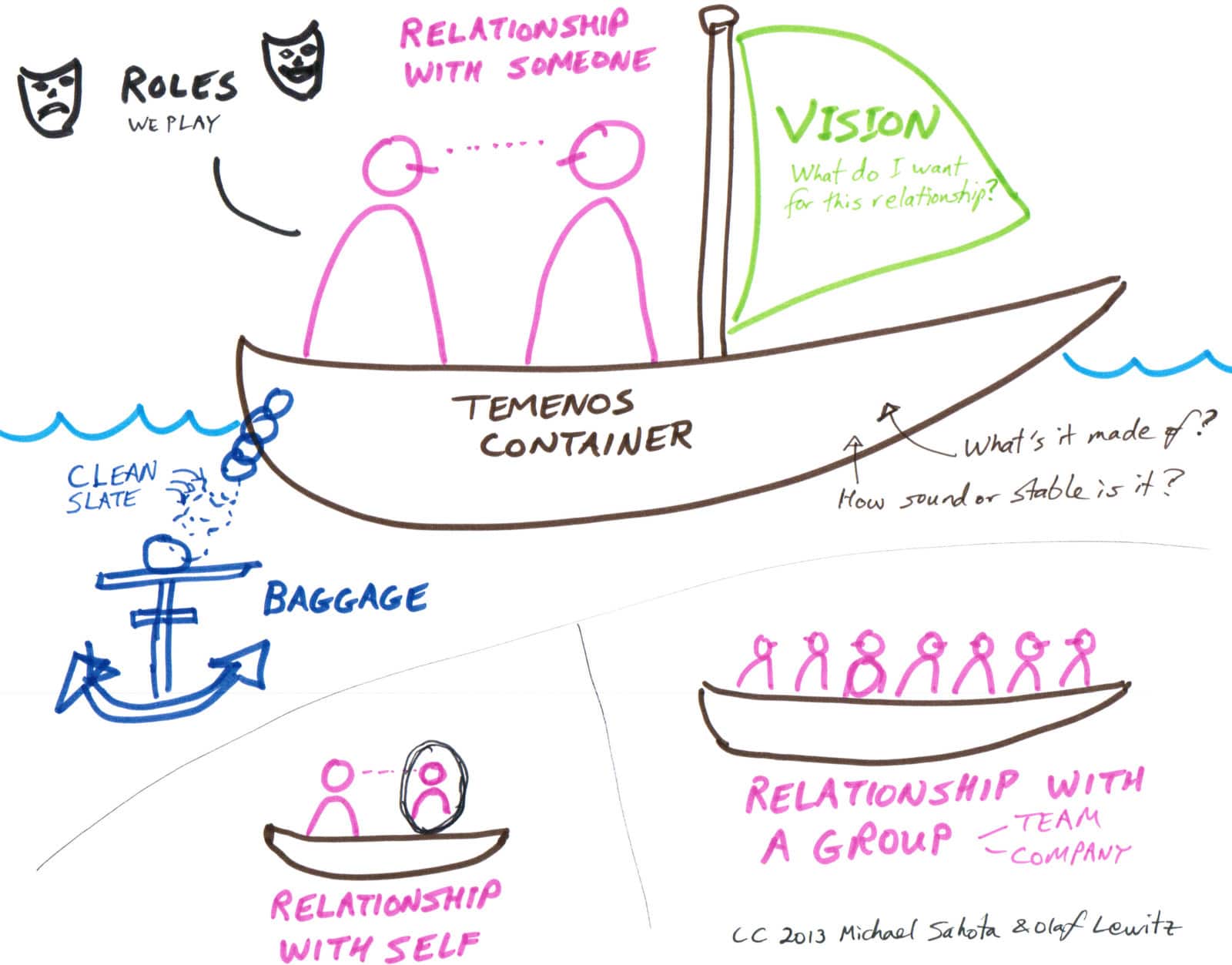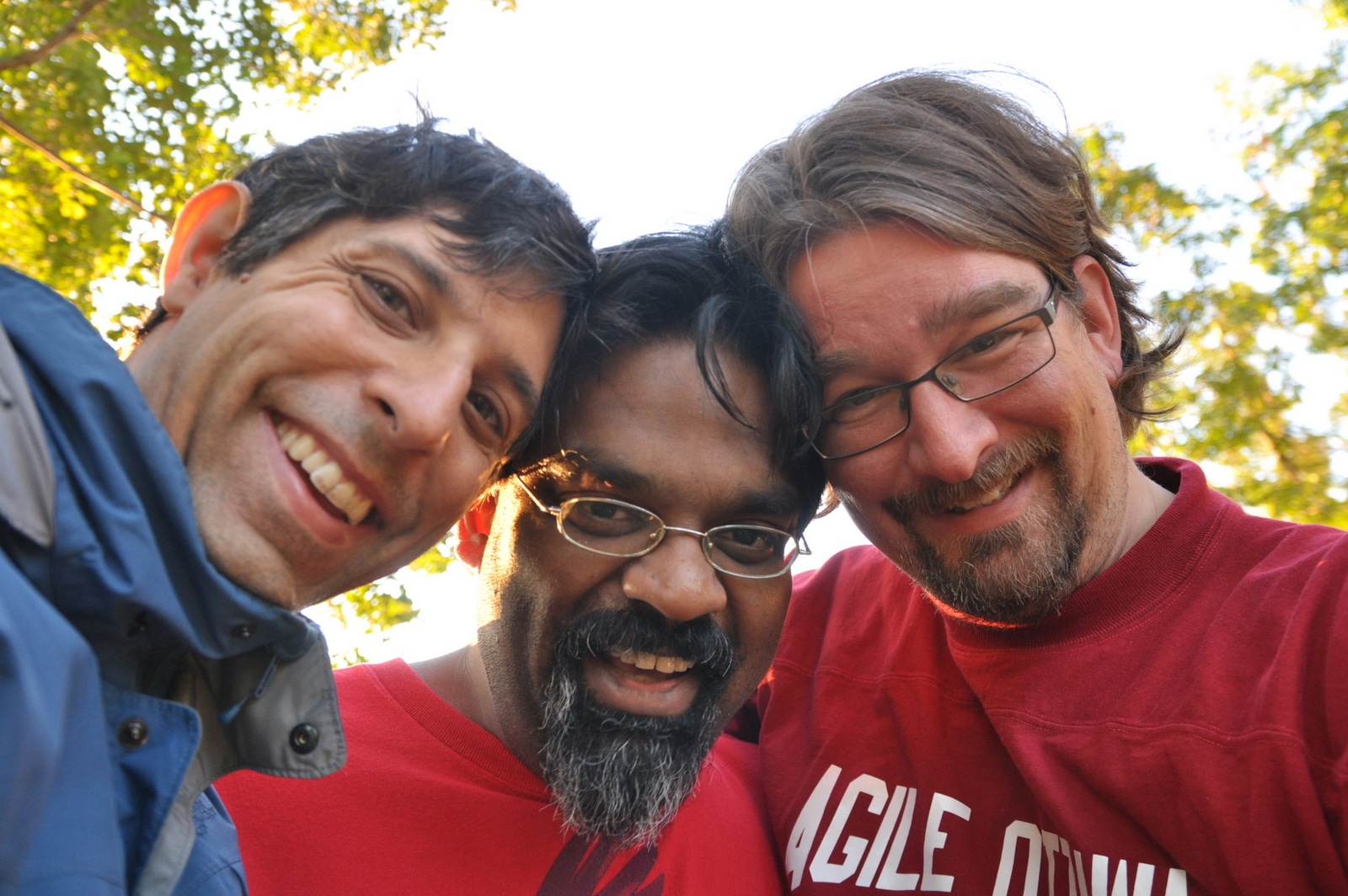“If we’re serious about exploring the world around us, we have to explore the world within us.” – Ken Robinson
(Joint post with Olaf Lewitz) The Temenos container provides a powerful mental model for understanding and improving relationships with others. Often we do not consider the larger context of the situations we are in. When we explicitly look beyond the specifics of a conversation or interaction to the relationship itself, we may more easily achieve relational flow. We use the term container to talk about the underlying fabric of our relationship with another person. The same notion can be used to understand groups we are part of as well as our relationship with ourselves. Consider the diagram below illustrating how containers may be used. For example, we may wish to imagine our vision for the relationship, the baggage of our history or the roles we play. 
Roles We Play
Dave Snowden has frequently pointed out that one specific dimension of the complexity of human systems is our ability to change roles (containers) from one second to the other. For example, when my wife calls me at work my role changes from colleague to husband. One set of beliefs, principles and values is replaced with another, potentially conflicting one. Each role we play applies to a specific context. We share most of these contexts with other beings. A container is the Temenos term to talk about these specific contexts. Within these containers we evolve the different roles we play in life. When we consciously examine our containers we can evolve the roles we play. Or evolve ourselves so that we behave the same across containers – to our true authentic self.
What is a Temenos?
Temenos is a Greek word for a transformational container, such as a separate piece of land dedicated to a king or god. It is a contained space of spiritual importance. With Temenos we hold all our containers as a sacred enabler to connection and relation with other human beings. The focus of this post is on the use of the container in the context of a relationship with another person and with ourself. The creation of a transformational Temenos container and how to leverage symbols of transformation will be the subject of another post. Containers In Our Lives In the history of our lives, these containers are formed: shared spaces for ourselves or others, each of which defines a unique identity (the role we play), unique habits we acquire, and adds specific emotional baggage to the load we carry around in our lives. We spend our lives in different containers. Each of them helps us to grow and be more of ourselves. For every container, we have needs that we want fulfilled and expectations we feel obliged to fulfill. Every time those needs are not met (or we think we don’t fulfill the needs) we are hurt: we think we fail the container or the container fails us. Some examplesy of such containers:
- Our self. This is the most important and challenging container for each of us.
- The family we grow up in.
- The friends we make, and lose, over the years.
- Teams we join, and leave, workplaces, clients…
- People who die.
- Relationships we start, and finish.
- Our children, the mutual unconditional love that challenges us and makes us whole.
All of these relationships, the roles we play in these and how they affect us can be framed as containers:
- Containers we join (some deliberately, some by chance)—born into a family
- Containers we leave (or that leave us)—divorce, death
- Containers we enter—coming home from work
- Containers we exit—leaving home for work
Olaf’s Story
When I created my first influence map and reflected on the containers which have been important in my life, I noticed I had unconsciously (though still deliberately) removed roles from my portfolio. For example, the relationship to my parents had transformed into a mutual friendship on eye level; same with my brother. I had effectively stopped acting as a son, and brother. Don’t get me wrong: we didn’t break up, the relationship became closer. Its quality had changed, and I noticed that not playing these roles gave me ease. So I thought: why not continue deliberately in that direction? How many roles do I want to and do I need to play? I haven’t found a definite answer yet. And I’ll stop being an employee soon, which is a step on this path.
Michael’s Story
One example of using the container model to improve a relationship is with my younger son, Sean. When I considered the whole of our relationship, I could see that I was failing him in providing attention to him as an individual (rather than as part of my pack of three kids). Once I had taken stock of the current situation and our history, I was able to create a vision for how I wanted our relationship to be. For this container, what I want is for me to really see him and for him to know that I really see the special, unique person he is. Our relationship has improved. And that for me is the whole point of containers: an opportunity to reflect and create a different path for ourselves.
Origins of Temenos
 Temenos is a special kind of experiential laboratory (usually delivered as a weekend lab) that Siraj Sirajuddin has created over many years integrating diverse influences such as Buddhist, Islamic, Jesuit and Hindu spirituality, mythology and Jungian psychology. He’s been using these labs to support lean and agile transformations in his practice as an Organisational Transformation Mentor.
Temenos is a special kind of experiential laboratory (usually delivered as a weekend lab) that Siraj Sirajuddin has created over many years integrating diverse influences such as Buddhist, Islamic, Jesuit and Hindu spirituality, mythology and Jungian psychology. He’s been using these labs to support lean and agile transformations in his practice as an Organisational Transformation Mentor.
Upcoming Workshops
- Toronto, April 27/28 – Michael
- Germany, July 19-20 (details tbd) — Olaf and Christine Heider
- Nashville, TN, August 2/3/4 – Before Agile 2013 – Olaf & Michael
- Washington, DC, monthly events (with Siraj)
Ping us if you are interested.


